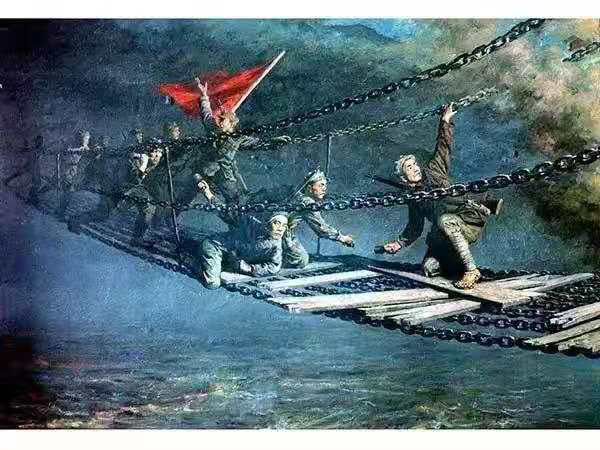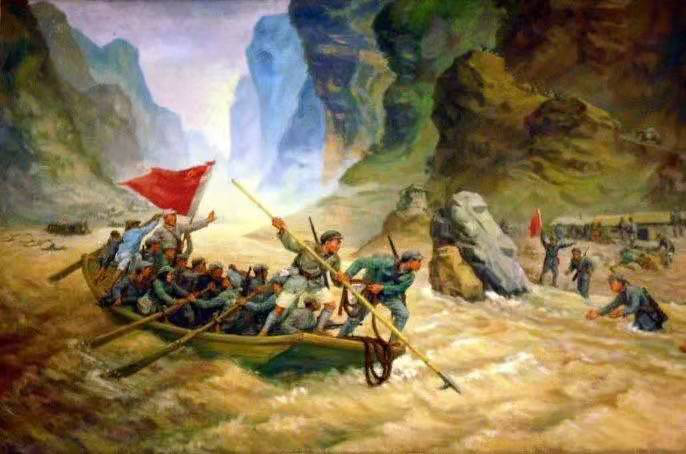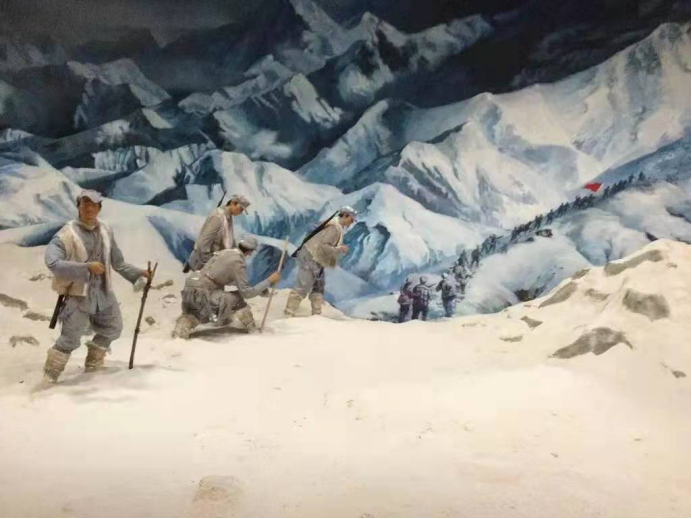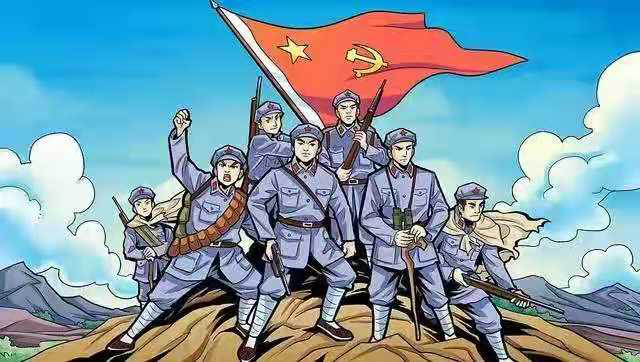In October 1934, during a civil war, embattled Chinese Communists broke through Nationalist enemy lines and began an epic flight from their encircled headquarters in southwest China. Known as the Long March, the trek lasted a year and covered some 776,7 miles. The Long March marked the emergence of Mao Zedong (1893-1976) as the undisputed leader of the Chinese Communists.

Civil war in China between the Nationalists and the Communists broke out in 1927. In 1931, Communist leader Mao Zedong was elected chairman of the newly established Soviet Republic of China, based in Jiangxi province in the southeast. Between 1930 and 1934, the Nationalists under Chiang Kai-shek (1887-1975) launched a series of five encirclement campaigns against the Chinese Soviet Republic. Under the leadership of Mao, the Communists employed guerrilla tactics to successfully resist the first four campaigns, but in the fifth, Chiang raised a huge force and built fortifications around the Communist positions. Mao was removed as chairman, and the new Communist leadership employed more conventional warfare tactics, and its Red army was decimated. With defeat imminent, the Communists decided to break out of the encirclement at its weakest points, and the Long March began in October, 1934. Secrecy and other tactics confused the Nationalists, and it was several weeks before they realized that the main body of the Red army had fled. The retreating force initially consisted of more than 85,000 troops, by some estimates, and thousands of accompanying personnel. Weapons and supplies were borne on men’s backs or in horse-drawn carts, and the line of marchers stretched for miles. The Communists generally marched at night, and when the enemy was not near, a long column of torches could be seen snaking over valleys and hills into the distance. Mao began to regain his influence, and in January, during a meeting of party leaders in the captured city of Zunyi, 1935, he re-emerged as a top military and political leader. He then changed strategy, breaking his force into several columns that would take varying paths to confuse the enemy. And the destination would now be Shaanxi province, in the northwestern region of the country, where the Communists hoped to fight the Japanese invaders and earn the respect of China’s masses.

After enduring starvation, aerial bombardment and almost daily skirmishes with Nationalist forces, Mao halted his columns in Huining County, Gansu in October, 1936, where they met other Red army troops. The Long March was over.
The Long March marked the emergence of Mao Zedong as the undisputed leader of the Chinese Communists. Learning of the Communists’ heroism and determination in the Long March, thousands of young Chinese traveled to Shaanxi to enlist in Mao’s Red army. After fighting the Japanese for a decade, the Chinese Civil War resumed soon after the end of World War II(1939-45). In 1949, the Nationalists were defeated, and Mao proclaimed the People’s Republic of China. He served as head of the Communist Party of China until his death in 1976.
第二次国内革命战争时期,中国工农红军三大主力从长江南北各根据地向陕北根据地进行的战略大转移。由于王明“左”倾冒险主义错误,红一方面军在第五次反“围剿”中失利,被迫实行战略转移。

1934年8月,红六、二军团作为大军西征的先遣队,已挺进湘西。同年10月,红一方面军及中央机关87000多人,从江西瑞金、于都、福建长汀、宁化等地退出根据地,开始长征。“左”倾冒险主义者实行退却中的逃跑主义,红军虽然突破四道封锁线,但伤亡过半,损失惨重。之后,根据军委多数同志主张,红一方面改变了突进湘西与二、六军团会师的计划,掉转方向,强渡乌江,于1935年1月占领遵义城。党中央在这里召开了政治局扩大会议,纠正了王明路线在军事指挥上的错误。会后,在毛泽东、周恩来、朱德、王稼祥等领导下,转战川滇黔边区、四渡赤水、迂回穿插,歼灭了大量敌人; 出其不意,佯攻贵阳、直逼昆明,胜利渡过了金沙江,摆脱了蒋介石数十万大军的围追堵截。同年5月,又顺利通过彝族地区,在彝族人民支持下,由安顺场越过大渡河天堑,进入大雪山区。6月到达四川懋功。旋与从川陕根据地长征前来张国焘率领的红四方面军会师。两军会师后,一方面军主张以取川、陕、甘三省为进军目标,张国焘则力主向康藏、青新地区退却。8月毛尔盖会议后,张国焘勉强同意北上,两军混编为毛泽东、周恩来率领的右路军和张国焘、朱德、刘伯承率领的左路军。但军至巴西后,张国焘公然南下,分裂红军,软禁朱德、刘伯承等人。中共中央在巴西召开紧急会议,对张国焘分裂主义错误作了严肃批评,为避免内部冲突,会议决定右路军单独北上。会后,右路军翻过六盘山、攻占腊子口,突破渭水、西(安)兰(州)大道封锁线,于1935年10月19日到达陕北吴起镇,同红十五军团会师,胜利结束了中央红军的长征。张国焘带领左路军南下后,于10月5日在卓木碉成立伪中央,自任书记,公开分裂党和红军。1936年7月,久战不利的左路军退至四川甘孜,随后与从湘西长征前来的红二方面军(由红二、六军团组成)会师。根据中央指示,二、四方面军共同北上抗日,过草地、翻雪山,终于1936年10月与红一方面军在甘肃会宁大会师。至此,长征胜利结束。

长征是中国历史记录上的第一次,在两年多的时间里,长驱二万余里,纵横十几个省,在党和民族的历史上写下了史诗般的篇章;长征的胜利,开创了中国革命的新局面。
心得体会:“红军不怕远征难,万水千山只等闲”。正是有了革命先辈们的浴血奋战,不畏牺牲,才换来了今天的和平、稳定、繁荣、富强。我们秉承着长征精神,奋斗在新的时代。2020疫情突袭时,是党组织领导着广大党员同志们冲在第一线。不论是抗疫一线的医生护士,还是各行各业的砥砺支持,党员同志们都走在了前面,不畏病毒,勇于奉献,更有许多青年火线入党,为抗疫贡献自己的力量。在危机时刻,是中国共产党挺身而出,带领广大人民群众积极应对,在最短的时间内控制住疫情,保障了人民生命的安全。
“雄关漫道真如铁,而今迈步从头越”。为喜迎建党100周年,今年全党开展党史学习教育,习近平总书记用“学史明理、学史增信、学史崇德、学史力行”十六个字道出了党史学习的深刻涵义。我们通过学习党史,以史为鉴,来对照自己的言行举止,不断提高自身的思想觉悟和政治修养,争做新时代的优秀党员。长征精神告诉我们,共产党员要有坚韧不拔、自强不息、勇往直前的精神,我为自己是一名共产主义接班人而倍感自豪!
—商务英语201团支部
秦玮彤
外国语学院团总支宣传部
编辑/陈思祯
排版/赵佳祺
图文/陈思祯 秦玮彤
审校/杨秦钰